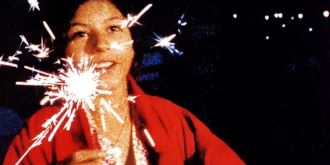
The Rose Seller 1998
Distributed by Pragda, 302 Bedford Ave., #136, Brooklyn, NY 11249
Produced by Erwin Goggel
Directed by Víctor Gaviria
Streaming, 115 mins
General Adult
Adolescents; Child Abuse; Drug Use
Date Entered: 05/31/2022
Reviewed by Andy Horbal, Cornell University Library“The Little Match Girl,” a fairy tale by the 19th-century Danish author Hans Christian Andersen, chronicles the final evening in the life of a poor little girl who freezes to death on New Year’s Eve rather than return home without having sold any of the matches she peddles at the behest of her father. In The Rose Seller, which originally premiered in competition at the Cannes Film Festival in 1998, director Victor Gaviria adapts Andersen’s story to the slums of Medellín, Colombia. The action begins on December 23. A ten-year-old girl named Andrea (Mileider Gil) runs away from home after being hit by her mother. She seeks out a 13-year-old friend from her neighborhood named Monica (Lady Tabares) who is already living on the streets. Monica and her friends decide to take Andrea under their collective wing by sharing the roses they sell to lovers enjoying a night out on the town with her to help them pay rent on the tiny apartment they all share. Much of this money also goes to pay for alcohol and drugs, most notably the glue which they huff out of discarded bottles and plastic bags.
Monica quickly emerges as The Rose Seller's clear protagonist, but the restless, mostly hand-held camera also spends a lot of time with Andrea and her other friends and people from their world, including a wheelchair-bound gang leader named Don Hector (Elkin Rodríguez) and his thugs. One of them, El Zarco (Giovanni Quiroz), first kills a man for basically no reason whatsoever, then steals a watch from Monica. The first third of the film follows them through the night of December 23, the second third through Christmas Eve day, and the final third through Christmas Eve night, with the last few moments taking place on Christmas morning. Quite a bit happens over the course of these 36 hours: at least four or five people die, and as many more get shot or stabbed. It isn’t portrayed as being any kind of exceptional time, though, but rather just another day-and-a-half on the dangerous streets these youths inhabit.
Like Hans Christian Andersen’s heroine, Monica and her friends all seem to have homes they could return to. They similarly have reasons to prefer to stay away. Andrea, like the Little Match Girl, is afraid that she will get a beating; Monica actually does go to her aunt’s house to take a nap but leaves after she awakens to find her uncle fondling her leg and he subsequently asks her how much her friends charge for a blowjob, then if he can kiss her belly button. Scenes such as this one and The Rose Seller’s many depictions of drug use are lent extra gravitas by the fact that characters are all played by nonprofessional actors and likely drawing on their actual experiences of being molested and getting high at ages when children in most societies would still be playing with dolls, not selling them for clothes and money.
The glue and the hallucinations it causes is where Gaviria’s film deviates furthest from the story he based it on. The kids in The Rose Seller seem to do a pretty good job of taking care of themselves, except when they’re stoned, which unfortunately is as often as possible. Then they stagger around with knives lunging at non-existent zombies and make themselves vulnerable in all sorts of other ways. Monica, like the Little Match Girl, sees visions of her deceased grandmother. Both girls are comforted by these images, but whereas for the latter they function entirely as a welcome distraction from the cold, which was going to kill her regardless, in Monica’s case they prevent her from realizing that El Zarco, displeased that the watch he stole from her was ruined when he got it wet, is stalking her with murderous intent. In other words, glue simultaneously provides Monica and her friends with a temporary escape from their hardscrabble lives, but also lowers their chances of survival. The point, I think, is that Gaviria sees drugs as a symptom, not the disease itself.
The Medellín of today is by all accounts a very different place from the one depicted in The Rose Seller. As described in a 2013 BBC News article, it went from being one of the most violent cities in the world to a “benchmark for good urban planning” in the two-decade-long period which began shortly before the film was made. It’s difficult to know whether or not Gaviria’s film, which played at a number of other prominent festivals in addition to Cannes and was Colombia’s submission for the 1998 Best International Feature Film Oscar, deserves some credit for this by raising global awareness of the city’s problems. Either way, it's an essential text for anyone interested in this transformation and Colombian cinema more generally.
Awards:Bogota Film Festival: Best Film, Best Director; Bratislava International Film Festival: Best Actress, Special Jury Prize; Havana Film Festival: ARCI-LUCA Award, Best Editing, CARACOL Special Award, Glauber Rocha Award, Grand Coral, OCIC Award; Miami Hispanic Film Festival: Best Director; Viña del Mar Film Festival: Best Actress, Best Director; Cartagena International Film Festival: Audience Award; Academy Award, Colombia’s Submission for Best Foreign Language Film; Cannes Film Festival, Palme d'Or Nomination; Ariel Awards, Mexico, Best Latin-American Film Nominee
Published and licensed under the Creative Commons Attribution 4.0 license. Anyone can use these reviews, so long as they comply with the terms of the license.